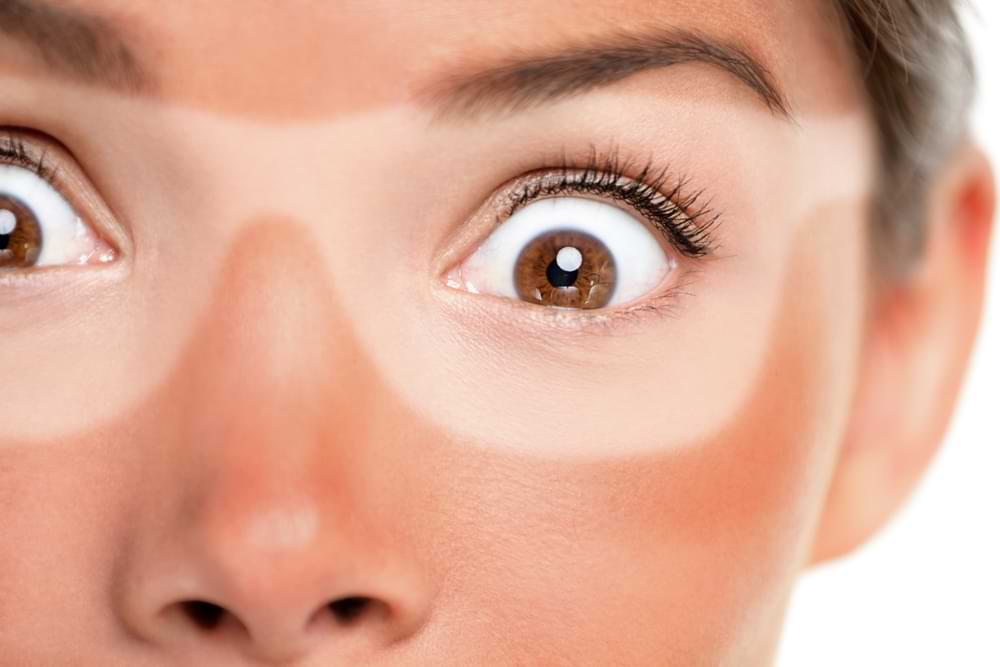Have you ever wondered what prolonged exposure to the sun is doing to your eyes? Do you know how UV rays can silently damage your vision?
Don’t make the mistake of believing that UV damage only affects the skin. It can severely impact your eyes too. In fact your eye are ten times more sensitive to sunlight compared to your skin!
For this reason, selecting the right eyewear is essential. Unfortunately, some people believe that all eye glasses offer UV eye damage protection, but that’s not necessarily the case.
I’m Nandita Chowdhurry, owner and principal optometrist at Picton Eyecare. With over 15 years of experience, I’m passionate about helping members of our community protect their vision. Living in the Wollondilly Shire, I understand the challenges of outdoor lifestyles and the importance of eye health. My goal is to provide you with essential information and practical tips to keep your eyes safe from UV damage.
By following the advice in this article, you can prevent serious eye conditions and maintain clear vision. But ignoring the dangers of UV exposure can lead to irreversible eye damage.
Early detection is key – book your eye exam today and let us help you prevent UV-related eye problems.
KEY TAKEAWAYS
- Eye Conditions and UV Exposure: Several common, and potentially serious eye conditions including cataracts and macular degeneration can be linked back to UV ray exposure.
- UV Protection: Wearing glasses or sunglasses with UV-blocking properties significantly reduces UV eye damage.
- Regular Eye Exams: Early detection of UV-related damage through regular eye exams can prevent long-term vision issues and ensure timely treatment.
What Causes UV Eye Damage?
The primary source of natural UV radiation is the sun, which emits a broad spectrum of electromagnetic radiation. This includes visible light, infrared light, and ultraviolet (UV) light. Ultraviolet (UV) radiation is divided into three types based on wavelength: UVA, UVB, and UVC. Each type affects different parts of the eye in unique ways.
- UVA has the longest wavelength and can penetrate deep into the eye, potentially damaging the macula, a part of the retina responsible for central vision.
- UVB has a shorter wavelength than UVA and is mostly absorbed by the cornea and lens of the eye.
- UVC has the shortest wavelength and is absorbed by the Earth’s atmosphere, meaning it doesn’t reach our eyes. Therefore, UVC doesn’t pose a risk to eye health in most natural environmental conditions.
These rays can penetrate clouds, making overcast weather just as hazardous for your eyes as sunny days. Additionally, UV exposure can reflect off surfaces like water, snow, and even concrete, increasing the risk of eye damage in various environments. Even staying in the shade only reduces UV by about 50%.
To understand more about the science of UV radiation and how it affects our body, watch the following video by Dr Michael Nelson.
Understanding Different Eye Conditions Caused by UV Exposure
UV rays can cause several eye conditions, each with its own set of symptoms and risks.
One of the most immediate effects is photokeratitis, also referred to as corneal sunburn, or snow blindness, which occurs when the eyes are subjected to excessive ultraviolet (UV) light. Individuals may experience redness, pain, and extreme sensitivity to light. These effects result from temporary damage to the surface cells of the eye. The condition typically resolves on its own with rest and protection from further UV exposure, but repeated occurrences can increase the risk of more severe eye problems.
Cataracts are another serious concern linked to prolonged UV exposure. Over time, UV rays can cause the lens of the eye to become cloudy, significantly impairing vision. This process accelerates with continued exposure, making cataract formation more likely. Fortunately, cataracts can be treated surgically, but prevention through adequate UV protection is preferable.
Macular degeneration, particularly age-related macular degeneration (AMD), is another condition exacerbated by UV exposure. The macula, a part of the retina responsible for central vision, deteriorates with UV damage, leading to vision loss.
Pterygium and pinguecula are abnormal conditions on the eye’s surface caused by UV exposure. Pterygium is a fleshy overgrowth of the conjunctiva, which can extend onto the cornea, potentially affecting vision. Pinguecula tends to be a yellowish bump that may cause discomfort. Treatments range from eye drops to surgical removal in severe cases.
Eyelids and Skin Cancer
Exposure to UV radiation significantly increases the risk of developing skin cancer on the eyelids. Despite the eyelids constituting a small percentage of the total skin surface area, they are disproportionately affected by skin cancer.
This overrepresentation is due to their delicate nature and frequent exposure to sunlight, often without adequate protection. The thin skin around the eyes provides less natural defense against harmful UV rays, making it more susceptible to damage and cancerous changes. Regular use of UV-blocking sunglasses and sunscreen can help mitigate this risk.
Aging and Eye Wrinkles
UV radiation accelerates the aging process of the skin, particularly around the eyes, leading to the formation of wrinkles. The delicate skin in this area is especially vulnerable to UV damage, as it is thinner and less protected by natural oils.
Prolonged exposure to UV rays breaks down collagen and elastin fibers, essential components that maintain the skin’s firmness and elasticity. As these fibers degrade, the skin loses its structure and begins to sag, resulting in fine lines and wrinkles.
Additionally, repeated squinting in bright sunlight can further contribute to the development of crow’s feet and other wrinkles around the eyes. Regular use of sunscreen, broad brim hats and protective eyewear can help prevent these effects.

Choosing Sunglasses for UV Eye Damage Protection
Wearing sunglasses with 100% UV protection is a key step, as they block all UVA and UVB rays. Look for wraparound styles, which provide additional coverage and prevent rays from entering from the sides. Wraparounds have the added bonus of shielding your eyes from wind, dust and pollen.
When you are buying sunglasses, always check the frames and/or packaging or a label which says one of two things:
- 100% protection against both UVA and UVB
- 100% protection against UV 400
If you’re unsure about the UV protection of your lenses take them to an optical store. They can be tested using a photometer. Most opticians will test them at no charge, and the process takes less than 30 seconds.
Dark sunglasses don’t necessarily provide greater protection. In reality, dark sunglasses that lack proper UV blocking can give a false sense of security by reducing glare and the need to squint in bright conditions. However, wearing very dark sunglasses without UV protection causes your pupils to dilate, allowing more harmful light to enter your eyes compared to not wearing sunglasses at all.
Other Eyewear Protection Options
Clear prescription glasses frequently have UV protection embedded in the lens material, but performance varies. Research from the University of Georgia found that while most clear prescription glasses provide some UV protection, the degree can range significantly, with some blocking as little as 10% of UV radiation. So it is important to check for quality.
Photochromatic lenses (a.k.a. transition lenses) can be a good option for those who are looking to combine the functionality of their prescription with the style and features of sunglasses. Photochromatic lenses darken when exposed to UV light but revert back to clear lenses within minutes when returning indoors. While the color of the lenses doesn’t affect UV protection, certain tints like brown, grey, and green can reduce glare and enhance contrast, improving visual comfort.
UV protective coating can be applied to lenses that lack inherent UV protection through a process where a special UV-blocking substance is layered onto the lens surface. UV coatings can be added to various lens materials, including plastic, glass, and polycarbonate, enhancing their ability to block both UVA and UVB rays.
Polarized lenses are particularly beneficial for eye comfort if you spend a lot of time near water or driving, as they reduce glare from reflective surfaces, enhancing visual clarity and reducing eye strain. But polarization alone has no protection from UV radiation.
In high-altitude locations, where UV radiation is stronger, protective measures become even more critical. In fact there is a 6%-10% increase in UV exposure for every 1000 ft. in elevation. Specific eyewear designed for such conditions is advisable. Snow goggles, for instance, are engineered to handle intense UV reflection from mountain snow.
Many contact lenses now offer UV protection, but they don’t cover the entire eye area, leaving parts exposed to UV rays. Combining these with a good pair of non-prescription sunglasses ensures comprehensive protection.
Complementing your sunglasses with a wide-brimmed hat adds another layer of protection by shading your eyes from direct sunlight.
Why Regular Eye Exams are Crucial
Why are regular eye exams so essential in protecting against UV damage? Regular eye exams play a critical role in detecting early signs of UV damage and other eye conditions. At Picton Eyecare, we use advanced technologies like OCT scans, digital retinal imaging, and visual field testing to thoroughly examine your eyes. These tools help identify any abnormalities or early damage caused by UV exposure, allowing for timely intervention.
Routine eye exams are vital for everyone, regardless of age or current vision health. They help in diagnosing conditions like cataracts, macular degeneration, and photokeratitis at an early stage. Early detection often leads to more effective treatment options and better outcomes.
For different age groups and those at higher risk, such as outdoor workers or individuals with a family history of eye conditions, eye exams should be more frequent. Typically, adults should get their eyes checked every two years, but those at higher risk might need annual exams.
CONCLUSION
UV rays can cause serious eye conditions, making UV eye damage protection essential. Wearing UV-blocking sunglasses and wide-brimmed hats can significantly reduce your risk of UV-related eye damage. Regular eye exams are also crucial for early detection and management of conditions caused by prolonged UV exposure.
Prolonged UV exposure without protection may result in permanent vision loss and decreased quality of life.
Protect your vision and enjoy peace of mind by scheduling your consultation with Picton Eyecare now.
You can call us on (02) 4603 2309 or arrange an appointment using the “Book Now” button in the navigation menu. We are conveniently located in the heart of Picton, NSW. There is plenty of parking available at the back of our store.

B.Optom (UoA), PGOT (UNSW)
Nandita is the principal optometrist of Picton Eyecare. She has over 15 years of extensive experience working in corporate and independent optometry practice. Opening Picton Eyecare in 2022 has fulfilled Nandita’s dream of an independent optometry practice, committed in serving the local community of Wollondilly and surrounding areas.
Nandita is caring and passionate about providing professional, personal and customised solution for every patient. She takes interest in all her patients and employs her skills and expertise to achieve the best possible outcome for the patient. She maintains great relationships with other medical professionals in the area.
Nandita is a local resident and has been working in the Southern Highlands for many years. She has a loyal following of patients who value her clinical and interpersonal relationships.
When not at work Nandita loves spending time with her family.
